#sangam literature
Text

#Aaina Mahal#Flagstone Panda Mandapam#Nadimi Padi Kavili#Viman Pradakshinam#an incarnation of Lord Vishnu#Sangam literature#Padi Kavali#Mahadwara Sampang#Laddus#Brahmotsavam#Brahma#Pradakshinam#Krishna Deoria#Mandapam#Rang Mandapam#Tirumala Rai#Sri Bedi Anjaneya Swamy Temple#Dhyan Mandiram#Charitable works and Devasthanam Trust#the hills of Tirumala#seven fauna of Sheshnag#seventh peak (Venkatachala) of Tirupati mountain#Sri Varadarajaswamy Shrine Potu#Mahant of Hatiramji#Lipakshi Emporium#System of food offerings#Panayaram#tirupati#Saptagiri#Balaji
0 notes
Text
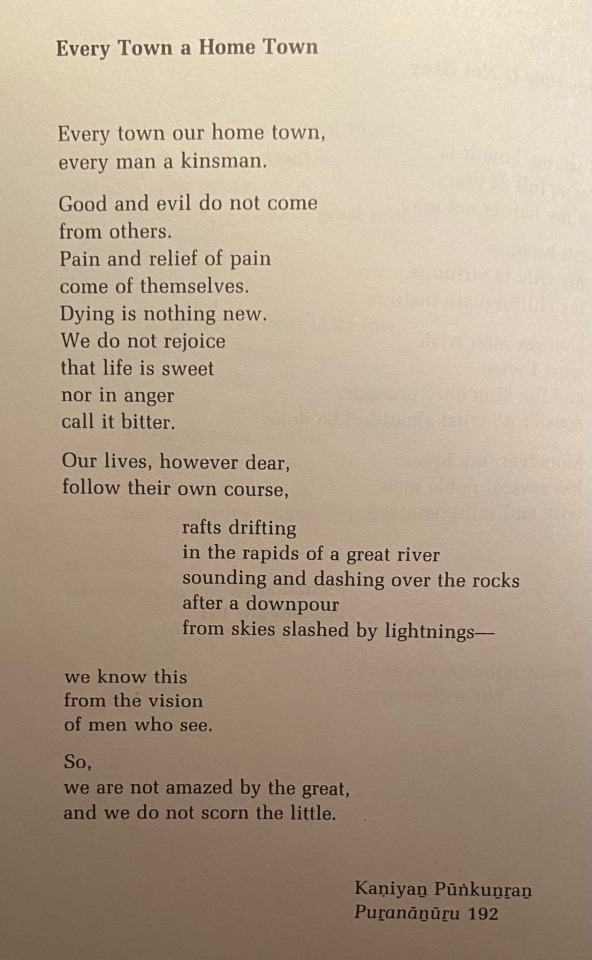
#my literal heart poem. you can’t reblog my old post because tumblr fucks formatting#sangam poetry#tamil literature#south asian literature#poetry
10 notes
·
View notes
Text
Thiruvilaiyadal - Part 1
As a movie buff, one of my core memory is seeing old classical Tamil films with my Amma. She made sure I saw all of her favorites and some of the 60s/70s classics.
Every summer holiday is filled with stories of old Tamil Puranas from my Appa and asking all the pieces of information and questions. And my interest in the Tamil language grew as I become older and thanks to all my Thamizh teachers who made the class so interesting with all the Tamil literature at school.
Everyone around me used to ask why I am into Puranas and literature when the modern world is thriving outside, but all I know was that my soul wanted more and more.
One such moment which captured my heart throughout was the movie 'Thiruvilaiyadal'.
Thiruvilaiyadal (Leelas in Sanskrit) is viewed to be one of the 18 thalapuranas. It is also revered as one of the Mahapuranas (Periya Puranam – the right eye of Shiva, Thiruvilaiyadal Puranam – the left eye, and Kanda Purana – the third eye). It was authored by Saint Paranjothi, estimated 300 years ago. It narrates the 64 Tiruvilayadals, loosely translated as the "playful miracles of god (Shiva) himself".
One such Thiruvilaiyadal of the god Siva was with Nakkeranar or Nakkerar. Nakkerar was a Post Sangam Tamil poet who wrote Thirumurukāṟṟuppaṭai.
The below poem is part of Kurunthogai, which was written by Irayyanar( God Shiva himself)
கொங்குதேர் வாழ்க்கை அஞ்சிறைத் தும்பி
காமம் செப்பாது கண்டது மொழிம��
பயிலியது கெழீஇய நட்பின் மயிலியல்
செறியெயிற் றரிவை கூந்தலின்
நறியவும் உளவோ நீயறியும் பூவே
Translation: O! Honey bee with beautiful wings, you live drinking nectar from selected flowers, tell me without bias look at my friend who resembles a peacock in beauty have you seen any flower that smells better than her hair?
The story goes as when ShenbagaPandiyan had a doubt regarding the scent of female hair and announced whoever clarify that doubt through poem/the best will be awarded 1000 gold coins. Dharumi was a poor poet who struggles for money went to lord shiva for help, lord Siva came in the guise of a poet and helped him with this poem. The king was happy that it solved his doubt as it says the women have naturally scented hair.
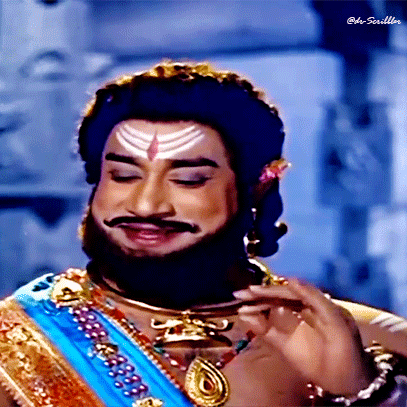

Scene 1: Siva introduces himself as a Tamil poet.
Scene 2: Dharumi doubts him and asks God Siva who is in disguise questions to prove his knowledge.
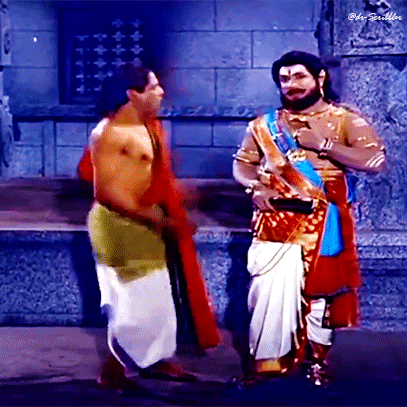
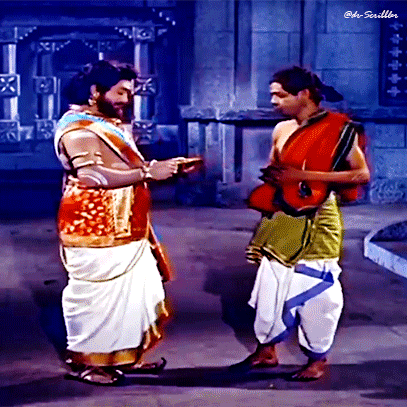
Scene 4: Dharumi apologizes for doubting God's knowledge
Scene 5: Dharumi gets the poem from god Siva and goes to present it before Pandya king.
When he was about to be awarded the Nakkerar the head poet of the Tamil Sangam stopped him, saying that the poem had a lot of mistakes, and denied the award and asked Dharumi to improve the poem. Dharumi went to lord shiva and told the same, lord shiva got angry that Nakkeerar found fault in his poem and went to an assembly and challenged Nakkeerar. But Nakkerar was not moved. Shiva asked Nakkerar if even the hair of the goddess did not have a natural hair scent?! Nakkerar asserted that it was so.


Scene 6: God Siva shows his true form by opening his third eye.
Scene 7: Nakkerar, now sees who is in front of him, even then he went on to say that a mistake is a mistake.
Shiva opened the third eye and was furious even then Nakkerar stood his ground, this shows his love for Tamil and shows the poet who he was. As he could not bear the scorching heat emanating from the divine eye he jumped into the water of the Golden Lotus Tank. Then at the request of the other poets, the Lord took Nakkeerar out of the tank and forgave him.
And that is how the story ends. Literally, nobody ever played God Siva more perfectly than Sivaji in Tamil cinema. As his name suggests he lived as God Siva. I wish I could able to translate the dialogue portion that happens at this part. But the sweetness and raw poetic Tamil lines could never be done justified during the transition.
I have to thank @themorguepoet for reminding me or taking me back to my memory where I cherish this classic with your post before.
#tamil#kollywood#siva#godsiva#pandiyan#sangam#poet#indian cinema#classic#Sivaji Ganesan#Thiruvilaiyadal#Kurunthogai#literature#love#indian aesthetic#india#hinduism#hindu mythology#Nakkerar#chola#shiva#desi aesthetic#bollywood
25 notes
·
View notes
Text
7 April 2023
Sangam era poetry and songs are so beautiful!
Unlike other "ancient Indian" poetry and songs, these are different imo because they talk of people and things which we find normal today.
They're extremely relatable: some talk of people being angry with their significant other, some talk about how beautiful the sunset from the city is, and some about how sad someone is feeling because their spouse passed away.
The poem below, for instance, is a romantic song.
youtube
And this one, is a song telling how a woman met her significant other.
youtube
It's all... Very human.
9 notes
·
View notes
Text
Sangam Era | संगम काल
The period roughly between the 3rd century B.C. and the 3rd century A.D. in south India (the area lying to the south of the rivers Krishna and Tungabhadra) is known as the Sangam Era.It has been named after the Sangam academies held during that period that flourished under the royal patronage of the Pandya kings of Madurai.At the sangams eminent scholars assembled and functioned as the board of…

View On WordPress
#Cheras#Cholas#Pandyas#Sangam Age#sangam age upsc#Sangam Era#Sangam Era Councils#Sangam Era in hindi#Sangam Era literature#sangam era map#sangam era period#sangam era tamil#sangam era upsc#Sangam Period#Sangam Period upsc#संगम काल
1 note
·
View note
Text
Mahabharata In Sangam Literature Bilingual post
It is necessary to shed light on other myths such as that Tamil and Sanatana Dharma have diametrically opposed views, the Aryans of the Northern Field opposed tamil, the Tamil veda and epic puranas were not accepted, the kings of the northern field were h
It is necessary to shed light on other myths such as that Tamil and Sanatana Dharma have diametrically opposed views, the Aryans of the Northern Field opposed tamil, the Tamil veda and epic puranas were not accepted, the kings of the northern field were hostile to the kings of Tamil Nadu, the kings and people of Tamil Nadu likewise hated the people of the north. This is because these castes give…
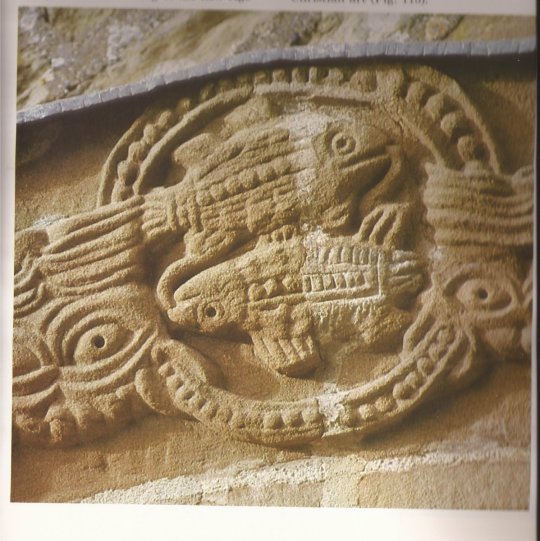
View On WordPress
#சங்க இலக்கியங்களில் மகாபாரதம்#சிறு பாணாற்றுப் படையில் மகாபாரதம்#புறநானூற்றில் மகாபாரதம்#பெருஞ்சோற்று உதியன் நெடுஞ்சேரலாதன்#பெரும்பாணாற்றுபா படையில் மகாபாரதம்#Mahabharat in Tamil literature#Mahabharat in Tamil Sangam literature#Sangam literature and Sanatan Dharma#Tamil and Sanatana Dharma
0 notes
Photo
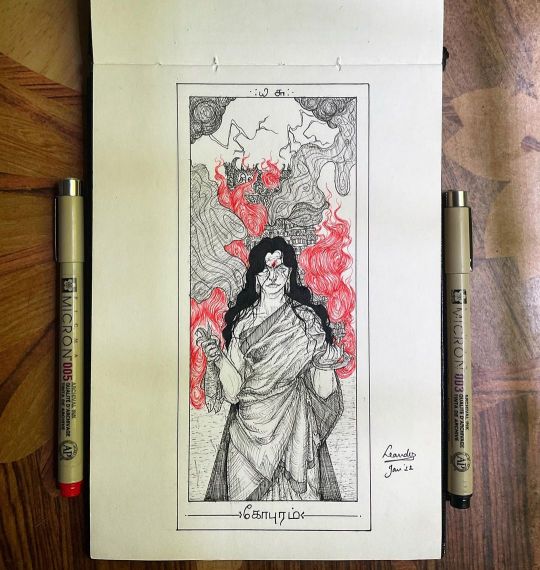
“கோபுரம்”/“Gopuram” (“The Tower”) “என்காற் சிலம்புபகர்தல் வேண்டி நின்பாற் கொலைக்களப் பட்ட கோவலன் மனைவி கண்ணகி யென்பதென் பெயரேயெனப்…” -சிலப்பதிகாரம் (62-64) Featuring the most iconic Tamil classical literary figure of all time- Kannagi from Ilangovadigal’s Silappadhikaram, here we have “The Tower” card ✨ (lmao I guess we’re making this a series after all💀). Drawing the Madurai Meenatchi Amman Temple (the one featured here is the West Gopuram) was definitely a task, but honestly it’s amazing how intricate the architecture is. Really loved incorporating the symbols of the silambu and the two dead fish representing the death of the Pandya King Nedunchezhiyan and Queen Kopperundevi. Oh and இனிய தமிழ் மரபு திங்கள் நல்வாழ்த்துக்கள் to all our Canadian Tamizh siblings!!! (Ik I’m late sorry 😩) #leanderscribbles #tamil #tamizh #tamizhar #tamilart #tamilartist #art #artist #tamilliterature #madurai #kannagi #silappathikaram #manimegalai #sangam #sangamliterature #symbolism #literature #lineart #blackandwhite #tarot #tarotcards #tarotart #tattooart #wicca #pagan #divination #occult #explore #instagram https://www.instagram.com/p/CYTCOhNBY9N/?igshid=NGJjMDIxMWI=
#leanderscribbles#tamil#tamizh#tamizhar#tamilart#tamilartist#art#artist#tamilliterature#madurai#kannagi#silappathikaram#manimegalai#sangam#sangamliterature#symbolism#literature#lineart#blackandwhite#tarot#tarotcards#tarotart#tattooart#wicca#pagan#divination#occult#explore#instagram
0 notes
Text
book recs masterpost
an ever-updating masterpost of books i've recommended. please check these before you ask for recommendations in case they've been covered —
fiction
"the tragedy still happened, but it was important that the love was there"
japanese literature
korean literature [1], [2]
gothic writing
spooky adult horror gothic
some favourites
marathi books
some ruskin bond
indian fiction [1], [2], historical fiction, stories, [3], [4]
non-fiction
general assorted ones i like
some favourites
about people living through crises
on geopolitics, foreign policy, international affairs
on political philsophy
vaguely sociology
biographies
on economic history
on the silk route
on prisons, convict labour
on afghanistan, soviet invasion, terror
capitalism
on language and linguistics
on the ancient and prehistoric world
just a bunch on india
the indus valley
indian aestheticism, art
gupta empire
sangam literature
on the northeast
india and southeast asia
nur jahan, mughal women | more
islamic conquest and state-making
on kashmir
assorted nonfiction
colonisation and aftereffects
on nationalism
on cities
on mumbai
on bollywood in bombay
on cities
on delhi
on kolkata
essays
history, migration, labour
art, reading, travel, gender, sports
nature, climate, some history
political economy, environmental and urban history, cartography and space
my comfort books
light reading
books that have got me out of my slumps
on art, photography, aesthetics, design [1], [2], [3]
on the environment
just some story and essay collections
#booklr#masterpost#book recs#book blog#reading list#reading#essays#literature#academia#faq#gaaaandaaaalf#book list#historyblr
2K notes
·
View notes
Note
I'm from the USA and took a lot of Indian history courses at my university. You might already know this or have guessed it, but a lot of what we learned was taught from a leftist--and at times explicitly Marxist--perspective. This was even stronger in other (but thankfully not all!) social studies departments where there were classes focusing solely on various social ills of Hinduism with regard to caste and issues of feminism, yet almost nothing negative could be said if it might be critical of Islam or Muslim figures, (Mahmud of Ghazni being a notable exception for one of my professors.) There was a whole class on British colonialism; no details were spared. Horrible famines in the Deccan, Odisha, Bengal. The decimation of the textile industry. Banning bharatanatyam. The salt tax. Accounts of how a British man kicked one of his servants to death, and another of how the poor and sick congregated outside the gates of a hospital in the south that at the time would only help Europeans. Jallianwala Bagh. But Aurangzeb? Completely whitewashed. You would think Sikhs carry a kirpan for no reason. It was only through reading additional books and documents for my essays and projects that I learned about how he tore down temples, smashed murtis (and stole valuable ones,) levied a double tax on non-Muslims, etc. I remember reading an account of a traveler going through the south at the time of the Deccan wars, remarking on how you could find entire villages empty and deserted fields full of unharvested crops because the people had fled advancing armies. In one region his forces simply killed some Telugu-speaking Brahmins serving the local king rather than force them to convert, and in another his forces captured a royal scribe, forced him to convert to Islam, and forcibly circumcized him before the man killed himself. Obviously the history of all things under the umbrella of Hinduism or any other system is not perfect, but there was a huge difference in how critical you could be of Hinduism (and even western traditions/ideas) compared to Islam.
Sometimes I daydream about what it would have been like to study Sangam literature in India or to experience Andal without needing an English translation, or going to translate old Sanskrit copies of the Mahabharata whose telling is unique to a certain village or something. But ultimately I'm glad I chose to be a research scientist instead and have a career in that, because I don't think I would have been able to succeed in academia unless I were a leftist. :\ Honestly I feel like even going to hang out with ISKCON for a few days would be a better introduction to Hinduism for the average person abroad with zero knowledge than a class called "Intersections of Gender and Caste in Hinduism" or something.
Very telling how Hinduism, and even Christianity is ripped apart in academia, yet when it comes to Islam, it is a religion of "tolerance, and beauty that respects women."
Honestly, though, it's because of how severely they react when their religion is criticized or even inspected. Apostates are given death, women who do not obey are given death, anyone who utters a word against their precious prophets is given, you guessed it! Death.
No religion is perfect, humans can be horrific creatures, and even Hinduism cannot escape that. But Islam has committed far more war crimes than any other religion.
It absolutely boils my blood to see traces of colonizers in our cities. One side of my family hails from Aurangabad, named aftre Aurangzeb, and you already know the atrocities he committed.
It's so fucking insidious to see how the youth have been told what to think. My own friend claimed to me, verbatim: "You cannot be neutral in the Israel-Palestine war. Either you support Palestine, or you support genocide."
Support Hamas? Support terrorism? The same terrorism that affects us? Has everyone forgotten 26/11?
It makes me so sad to think of the future we could have had. Sanskrit would be the most spoken language, instead of English. Gurukuls would exist, and India would still have all of its wealth.
You're right, even ISKCON is better than the propaganda they feed people about our religion.
#anon asks#answered#hinduphobia#anon i'm glad you didnt get brainwashed thats the silver lining at least#hindublr
34 notes
·
View notes
Text
V Venkayya, the scholar who rediscovered ‘Ponniyin Selvan’ Raja Raja Chola

In the early 20th century, the name of the king who built the big temple of Thanjavur was not known; some believed it was built by Karikala Chola, who lived in the Sangam age, around 1,000 years before Raja Raja . . . (Read the full article by clicking on the title)

Venkayya's handwriting
As an author and editor, Kalki was aware of the role of literature and archeological studies. He acknowledged it through Aditha Karikalan's words in the Ponniyin Selvan.
No, Parthiba, no. We've never heard of a dynasty that lasts forever. Even the Ikshvaku dynasty to which Rama belonged, came to an end. The Rashtrakutas made their appearance in order to defeat the Chalukyas. It’s natural for kingdoms to reach their heights sometimes and eat dust at others. Some kingdoms attain great prosperity, then disappear without a trace.
Just look at my ancestors! Karikala Valavan, Killi Valavan and other Chozha kings like them lived a good life and achieved fame. But what do we know of them now? We know their names only because there were poets who sang in praise of them. We do not even know whether what the poets sang was true, or whether they were so drunk that they sang whatever came to mind. But these architectural masterpieces that Mahendrar and Mamallar created will remind people of their greatness for thousands of years.
Compared to them, what have you or I achieved? We killed thousands of men in battle, we made rivers of blood flow. What else have we done to perpetuate our names?
@willkatfanfromasia @celestesinsight @favcolourrvibgior @harinishivaa @sakhiiii @ambidextrousarcher @sampigehoovu @balladedutempsjadis @whippersnappersbookworm
#ponniyin selvan#ponniyin selvan 2#aditha karikalan#aditya karikalan#kundavai#arul mozhi#arulmozhi varman#arunmozhi varman#rajaraja chola#chola dynasty#vallavaraiyan vandiyadevan#vanthiyathevan
42 notes
·
View notes
Text
KODAIKANAL TRIP
EXPLORE & INSPIRE
The earliest references to Kodaikanal and the Palani hills are found in Tamil Sangam literature.[3] Tamil composition Kuṟuntokai, the second book of the anthology Ettuthokai, mentions the mountainous geographic region (thinai) of Kurinji. The region is associated with Hindu god Murugan and is described as a forest with lakes, waterfalls and trees like teak, bamboo and sandalwood.[4] The name of the region, Kurinji, derives from the name of the famous flower Kurinji found only in the hills and the occupants of the region were tribal people whose prime occupations were hunting, honey harvesting and millet cultivation.[5][6] The hills were populated by the Palaiyar tribal people.[7]Coakers Walk in 1900
In 1821, a British Lieutenant, B. S. Ward, climbed up from his headquarters in the Kunnavan village to Kodaikanal to survey the area and reported of beautiful hills with a healthy climate with about 4,000 people living in well-structured villages.[8] In 1834, J.C Wroughten, then revenue collector of Madura and C. R. Cotton, a member of the Madras Presidency's board of revenue, climbed up the hills from Devadanapatti.[9] In 1836, botanist Robert Wight visited Kodaikanal and recorded his observations in the 1837 Madras Journal of Literature and Science.[10] In 1852, Major J. M. Partridge of the Bombay Army built a house and was the person to settle there.[9] In 1853, only six to seven houses were there when then Governor of Madras Presidency Charles Trevelyan visited in 1860.[11] In 1862, American missionary David Coit Scudder arrived.[9] In 1863, acting on a suggestion of Vere Levinge, then collector of Madurai, an artificial lake was formed.[11]
In 1867, Major J. M. Partridge imported Australian eucalyptus and wattle trees and in 1872, Lt. Coaker cut a path along the steep south east facing ridge which overlooks the plains below and prepared a descriptive map the region.[12][13] In the later half of the 19th century, it became a regular summer retreat for American missionaries and other European diplomats as a refuge from the high temperatures and tropical diseases of the plains.[14][15] In 1901, the first observations commenced at the Kodaikanal Observatory.[16] In 1909, the area had developed into a small town with 151 houses and a functioning post office, churches, clubs, schools and shops.[14] In 1914, the ghat road was completed.[11] It continued to served as a summer retreat during the British Raj and became a popular hill station later.
1 note
·
View note
Text
HISTORY OF TAMIL NADU
Name :Sanjith Y
Dep:B A HISTORY(EM)
REG NO:2121E0246
EMAIL ID: [email protected]
The history of Tamil Nadu is rich and diverse, spanning thousands of years. While it's challenging to cover its entire history in just 1000 words, I can provide a concise overview of key periods and developments.
1. **Ancient History (300 BCE - 300 CE):**
Tamil Nadu's history can be traced back to the Sangam period, characterized by the flourishing of Tamil literature. The Sangam texts, composed between 300 BCE and 300 CE, provide insights into the early Tamil society, culture, and politics.
2. **Medieval Period (7th - 14th Century):**
The Chola dynasty, one of the most prominent in Tamil Nadu's history, ruled during this time. They expanded their empire across South India and Southeast Asia. The Cholas made significant contributions to art, literature, and temple architecture.
3. **Vijayanagara Empire (14th - 17th Century):**
The Vijayanagara Empire, although not Tamil, influenced the region. They promoted the growth of the Tamil language and culture. Temples and grand architectural projects were undertaken during this period.
4. **Nayak and Maratha Rule (17th - 18th Century):**
After the decline of the Vijayanagara Empire, Tamil Nadu saw the rise of various Nayak dynasties and later, the Marathas. The Nayaks continued to promote Tamil culture and literature.
5. **British Colonial Rule (18th Century - 1947):**
The British East India Company established control over Tamil Nadu in the 18th century. The region played a crucial role in the Indian independence movement. Prominent leaders like C. Rajagopalachari and Periyar E.V. Ramasamy emerged during this period.
6. **Independence and Post-Independence Era (1947 - Present):**
India gained independence in 1947, and Tamil Nadu played a significant role in the formation of the Indian Republic. The state has been politically active, with the Dravidian movement advocating for regional autonomy and social reform.
7. **Cultural Heritage:**
Tamil Nadu has a rich cultural heritage, including classical dance forms like Bharatanatyam, traditional music, and a vibrant literary tradition. Temples like the Brihadeeswarar Temple in Thanjavur and the Meenakshi Temple in Madurai are architectural marvels.
8. **Language and Literature:**
Tamil is one of the oldest surviving classical languages in the world. It has a vast body of literature, including the Sangam poetry, religious texts, and modern works by literary giants like Subramania Bharati and Kalki Krishnamurthy.
9. **Economy and Industrialization:**
Tamil Nadu has a diverse economy, with sectors like manufacturing, agriculture, and services playing crucial roles. The state has become an industrial hub with a focus on automotive manufacturing and information technology.
10. **Political Landscape:**
The state has been known for its dynamic and competitive politics. Dravidian parties, the DMK (Dravida Munnetra Kazhagam) and AIADMK (All India Anna Dravida Munnetra Kazhagam), have dominated the political scene. Key leaders include M.G. Ramachandran, M. Karunanidhi, and J. Jayalalithaa.
11. **Social Reforms:**
Tamil Nadu has a history of social reform movements, addressing issues like caste discrimination and women's rights. Figures like Periyar E.V. Ramasamy played pivotal roles in these movements.
12. **Education and Science:**
Tamil Nadu is known for its educational institutions like the Indian Institute of Technology (IIT) Madras and the Indian Institute of Management (IIM) Trichy. It has contributed significantly to fields such as science, technology, and healthcare.
13. **Cinema:**
The state is a hub for the Indian film industry, with the Tamil film industry, or "Kollywood," producing a vast number of films. Superstars like Rajinikanth and Kamal Haasan have gained international recognition.
14. **Recent Developments:**
Tamil Nadu has witnessed various infrastructural developments, including metro rail projects, and has continued to focus on economic growth and social welfare.
In summary, Tamil Nadu's history is a tapestry of ancient civilizations, colonial influence, political movements, cultural richness, and economic progress. Its legacy continues to shape the social, political, and cultural landscape of modern India.
2 notes
·
View notes
Text
Kerala Mytho series :-
2) Kanjirottu Yakshi
Story✨
Sreedevi or Chiruthevi was a courtesan who had as her clients the high and the mighty, and who enjoyed toying with the lives of her many admirers and driving them to financial ruin. However, she fell in love with Kunjuraman, her palanquin-bearer, who would carry both her and her brother Govindan around on his back. However, Kunjuraman was already married and did not reciprocate Chiruthevi's feelings. On the other hand, Govindan and Kunjuraman were very close, with some versions of the tale claiming that the two were lovers.
Frustrated by Kunjuraman's romantic indifference towards her, Chiruthevi arranged for Kunjuraman's wife to be killed. When Govindan found out that his sister was behind the plot, he told Kunjuraman, who agreed to sleep with Chiruthevi. While they were in bed, Kunjuraman strangled Chiruthevi in order to avenge the murder of his wife.
Yakshi on the loose
Chiruthevi was reborn as a yakshi to a couple in Kanjirottu. She magically transformed into a bewitchingly beautiful woman moments after her birth. As a yakshi, she proceeded to seduce and terrorize men and drink their blood, never forgetting to harass the still-living Kunjuraman, whom she still desired.
The Divine Deal
To help Kunjuraman, Govindan, who was also a great upasaka of Lord Balarama, made a deal with the yakshi whereby she could cohabit with Kunjuraman for a year, after which she was to become a devotee of Narasimha. The other conditions of this deal were that she must agree to be installed at a temple after the year was up, and that she must pray for Govindan and his relationship with Kunjuraman in this birth and all subsequent ones. The yakshi swore on 'ponnum vilakkum' in agreement, and after the year was up, she was installed at the Kanjiracottu Valiaveedu Temple which was destroyed many years later.
The Divine Goddess
A year after her deal with Govindan, the yakshi was installed at a Temple which later came to be owned by Kanjiracottu Valiaveedu. The members of Valiaveedu started worshipping this Yakshi besides their Guardian Deities, Lord Ramanuja (Sri Krishna accompanied by Sri Rukmini) and Lord Balarama. Devotees used to offer Pongala to Yakshi Amma on Pooram in the month of Meenom and on the first Fridays in every Malayalam month except Meenom. The Temple no longer exists.
The Guardian of the Mystery Vault
After becoming a devotee of Narasimha, the Yakshi is now believed to reside in Vault (or 'Kallara' in Malayalam) B of the ancient Sri Padmanabhaswamy References to the temple have appeared in literature dating back to the Sangam era, though nobody is certain of when it was constructed. It is currently managed by the royal family of Travancore. Vault B is one of six vaults of the temple, five of which were opened. However, Vault B remains unopened due to ongoing legal issues, as well as the legend that suggests that while even bigger treasures lie within the vault, any attempt to open it would stir up the Kanjirottu Yakshi, interrupting her prayers to Lord Narasimha and unleashing her evil upon the world. As Princess Ashwathi Tirunaal Gouri Bayi observes, "Disturbing her peace would be a disaster especially if her current quiet temperament reverts to the menacing nature that was once hers."The enchanting and ferocious forms of this Yakshi are painted on the south-west part of Sri Padmanabha's shrine.
*Yes , guys . We worship Yakshi as a Goddess/ Mother Goddess
I just love Padmanabhaswamy temples especially the B-Vault mystery. *
**********************************
I am also planning to Start a series of Kerala Ghost stories. Which is literally creepy.
Anyways, if you like this series , do comment your opinion. Or any doubts regarding Any mythology related to Kerala. I know Kerala has this , dark cult worships because Kerala is literally a 'Tantric state' , all the Temples here follow Tantric style of worship, which is soo cool to see .
So , Will come back with another interesting Kerala Mystical / mythological stories..
To be Continued...
#series: kerala mythos#Padmanabhaswamy temple#Yakshi#Goddess#unknown stories of sanatan#tantric#to be continued
3 notes
·
View notes
Text
TAMIL CULTURE
Tamil culture refers to the rich heritage and traditions of the Tamil-speaking people, who primarily inhabit the Indian state of Tamil Nadu and the northeastern region of Sri Lanka. Tamil culture has a history that spans over 2,000 years and encompasses various aspects such as language, literature, music, dance, art, cuisine, and religious practices.
Language: The Tamil language is one of the oldest surviving classical languages in the world. It has a distinct script and a vast body of literature, including ancient Sangam literature, which consists of poems and epics.
Literature: Tamil literature is renowned for its poetry, prose, and philosophical works. The Sangam literature, composed between 300 BCE and 300 CE, is highly celebrated. Prominent Tamil poets like Thiruvalluvar and Subramania Bharati have made significant contributions to Tamil literature.
Music and Dance: Tamil culture has a rich musical tradition. Classical music, known as Carnatic music, originated in the region. Traditional musical instruments like the veena, mridangam, and flute are commonly used. Bharatanatyam, a classical dance form, is also deeply rooted in Tamil culture and is known for its expressive movements and intricate footwork.
Festivals: Tamil culture is characterized by numerous colorful festivals celebrated throughout the year. Pongal, the harvest festival, is one of the most important celebrations. Other significant festivals include Tamil New Year (Puthandu), Karthigai Deepam, and the Tamil version of Diwali (Deepavali).
Cuisine: Tamil cuisine is diverse and flavorful. It is known for its extensive use of rice, lentils, spices, and coconut. Popular dishes include idli, dosa, sambar, rasam, and biryani. Tamil Nadu is also famous for its filter coffee and various sweets and snacks.
Now, moving on to Tamil beauty, Tamil culture appreciates natural beauty and emphasizes the concept of inner beauty. However, there are certain traditional beauty practices that have been passed down through generations. Here are a few aspects:
Traditional Attire: Tamil women traditionally wear sarees, which are draped in different styles across the region. The sarees are often adorned with intricate designs, embroidery, and vibrant colors. Men typically wear a dhoti or a veshti, which is a traditional wrap-around garment.
Jewelry: Jewelry holds great significance in Tamil culture. Women wear a variety of ornaments such as necklaces, earrings, bangles, and anklets. Traditional pieces like the thali (mangalsutra) and oddiyanam (waist belt) are often worn during weddings and other auspicious occasions.
Mehndi: The application of mehndi, or henna, is a common beauty practice among Tamil women. Intricate patterns are created on the hands and feet during special occasions and festivals.
Natural Remedies: Tamil culture has a long tradition of using natural ingredients for skincare and haircare. Traditional recipes involve the use of herbs, oils, and natural substances like turmeric and sandalwood to enhance beauty.
Hairstyles and Makeup: Tamil women traditionally wear their hair long and often braid it or tie it up in various styles. In terms of makeup, a minimalistic approach is often preferred, with a focus on enhancing natural features.
It's important to note that Tamil culture is diverse, and practices may vary among different communities and regions within Tamil Nadu and Sri Lanka.
3 notes
·
View notes
Text
சங்க இலக்கியங்களில் மகாபாரதம்.இது இருமொழி இடுகை
தமிழும் சனாதன தர்மமும் ஒன்றுக்கொன் று எதிர்மாறான கருத்துக்களைக் கொண்டவை, வட புல ஆரியம் தமிழை எதிர்த்தது, தமிழ் வேத மற்றும் இதிகாச புராணங்களை ஏற்றுக்கொள்ளவில்லை It is necessary to shed light on other myths such as that Tamil and Sanatana Dharma have
தமிழும் சனாதன தர்மமும் ஒன்றுக்கொன் று எதிர்மாறான கருத்துக்களைக் கொண்டவை, வட புல ஆரியம் தமிழை எதிர்த்தது, தமிழ் வேத மற்றும் இதிகாச புராணங்களை ஏற்றுக்கொள்ளவில்லை,வட புல அரசர்கள் தமிழக அரசர்களுடன் பகைமை பூண்டு இருந்தனர்,தமிழக மன்னர்களும் மக்களும் அவ்வாறே வட புலத்தவரை வெறுத்தனர் இன்ன பிற கட்டுக்கதைகளை வெளிச்சம் போட்டுக் காட்டுவது இன்றியமையாதது. ஏனெனில், தவறான வரலாற்றையும் அதன் காரணமாக பிரிவினைக்கும்…

View On WordPress
#சங்க இலக்கியங்களில் மகாபாரதம்#சிறு பாணாற்றுப் படையில் மகாபாரதம்#தமிழ் இலக்கியத்தில் சனாதன தர்மம்#தமிழ் இலக்கியத்தில் மகாபாரதம்#புறநானூற்றில் மகாபாரதம்#பெருபானாற்றுப் படையில் பாரதம்#Mahabharat in Sangam literature#Mahabharat in Tamil literature#Sangam Classics and Hinduism
0 notes
